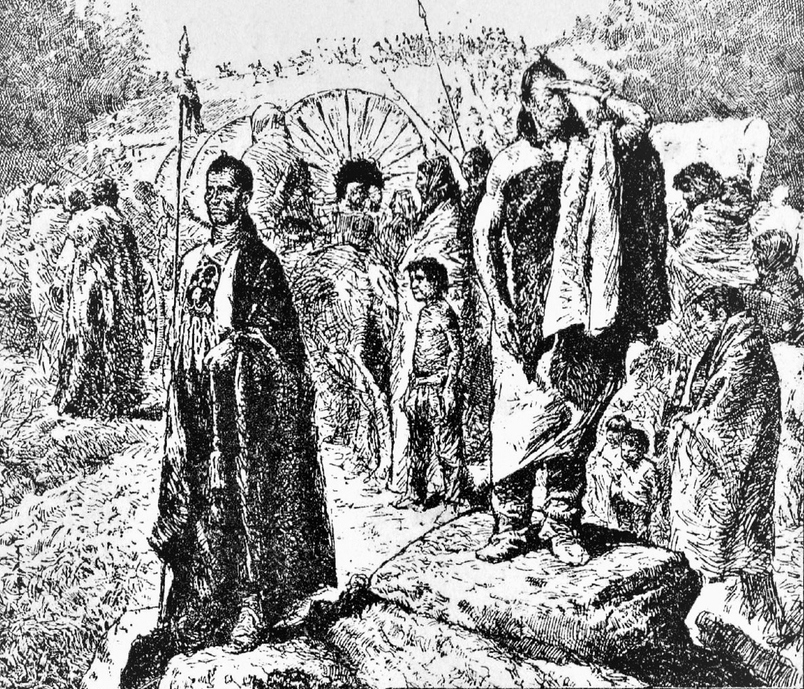With the Removal Act of 1830, the U.S. Government strengthened the ability of the government to displace Indians from their tribal lands through the use of treaties. As a last resort, the government sometimes violated both treaties and Supreme Court rulings in their aims to facilitate the spread of European Americans across the continent.
James Monroe and Thomas Jefferson advocated that Indian tribes in the Southeast be given land west of the Mississippi River, but neither took action to make this happen.
In the early 19th century, Americans flocked to the coasts of the South in search of land and took up residence in the backcountry of what would later become Alabama and Mississippi. White settlers petitioned the federal government to remove Indian tribes living there because they appeared to be the main hindrance to western expansion. James Monroe and Thomas Jefferson advocated that Indian tribes in the Southeast be given land west of the Mississippi River, but neither took action to make this happen. The first major transfer of land only happened as the result of war.
Jackson’s expedition against the Creek Indians culminated in his victory at Horse Shoe Bend (in present-day Alabama near the Georgia border) where his massive army decimated the Creeks’ military might. As a result, he forced the Indians to sign a treaty in which they surrendered twenty million acres of their traditional lands to the United States — an area equal to an eighth of the state of Alabama and a fifth of Georgia today. For the next decade, Jackson led the Indian removal campaign, helping to negotiate nine of eleven major treaties for the removal of Indians.

The Creek, Cherokee, Chickasaw, and Choctaw were among the Native American tribes who realized that they could not beat the Americans in war under this kind of pressure. As settlers’ hunger for land continued, the Indians decided to adopt a policy of appeasement. Even if they gave up most of their land, they would be able to keep some of it. Appeasement and resistance did not work in Florida, as the Seminole tribe fought in the Second Seminole War (1835–1842) and the Third Seminole War (1855–1858).
The United States Constitution gives Congress the legal authority to “regulate commerce with foreign nations, among the several States, and with Indian tribes.” The Indian tribes traditionally declared themselves “to be under the protection of the United States of America, and of no other sovereign person” in early treaties negotiated between the federal government and the tribes. When Andrew Jackson became president (1829–1837), he determined to use these legal precedents to create a systematic strategy to Indian removal.
The Indian Removal Act left Jackson and his supporters free to convince, bribe, and threaten tribes to sign removal treaties and leave the Southeast.
Jackson pushed Congress to pass the Removal Act of 1830 in order to fulfill his goal. The Act provided a procedure by which the President might award territory west of the Mississippi River to Indian tribes who agreed to relinquish their ancestral grounds. The statute provided financial and material support to the Indians in order for them to move to their new sites and begin new lives, as well as a guarantee that the Indians would dwell on their new property under the protection of the United States Government for the rest of their lives. With the Act in effect, Jackson and his supporters were free to convince, bribe, and threaten tribes to sign removal treaties and leave the Southeast.
In general, Jackson’s administration was a success. By the end of his presidency, he had signed nearly seventy removal treaties, which resulted in the relocation of nearly 50,000 eastern Indians to Indian Territory (defined as the portion of the United States west of the Mississippi River that does not include the states of Missouri and Iowa, as well as the Territory of Arkansas) and the opening of millions of acres of fertile land east of the Mississippi to white settlers. Despite the expanse of the Indian Territory, the government planned for the Indians to settle in a smaller area—what would ultimately become eastern Oklahoma.
The Cherokee Nation, on the other hand, refused to challenge in court Georgia legislation restricting their liberties on tribal territories. Chief Justice John Marshall declared in Cherokee Nation v. the State of Georgia in 1831 that “the Indian territory is admitted to compose a part of the United States,” that the tribes were “domestic dependent nations,” and that “their relation to the United States resembles that of a ward to his guardian.” The Supreme Court, on the other hand, reversed itself the next year, ruling that Indian tribes were sovereign and free from Georgia laws. Despite this, President Jackson refused to accept the Court’s ruling.
According to the best evidence, between three and four thousand Cherokees died en route due to the harsh conditions of the “Trail of Tears.”
In the Treaty of New Echota, he acquired the signature of a Cherokee chief agreeing to removal, which Congress ratified in 1835 against Daniel Webster and Henry Clay’s protests. The Cherokee signing party constituted only a small portion of the Cherokee people, who flocked to Principal Chief John Ross in a last-ditch effort to keep their territory. This endeavor failed in 1838, when the Cherokee tribe was pushed to the arid plains across the Mississippi by federal troops and Georgia state militia. According to the best evidence, between three and four thousand Cherokees died en route due to the harsh conditions of the “Trail of Tears.”
By the 1840s, there were no Indian tribes in the American South from the Atlantic to the Mississippi, with the exception of a tiny number of Seminoles still resisting removal in Florida. The United States Government was successful in preparing the way for westward expansion and the inclusion of new territories as part of the United States through a combination of coerced treaties, treaty noncompliance, and judicial determination.


